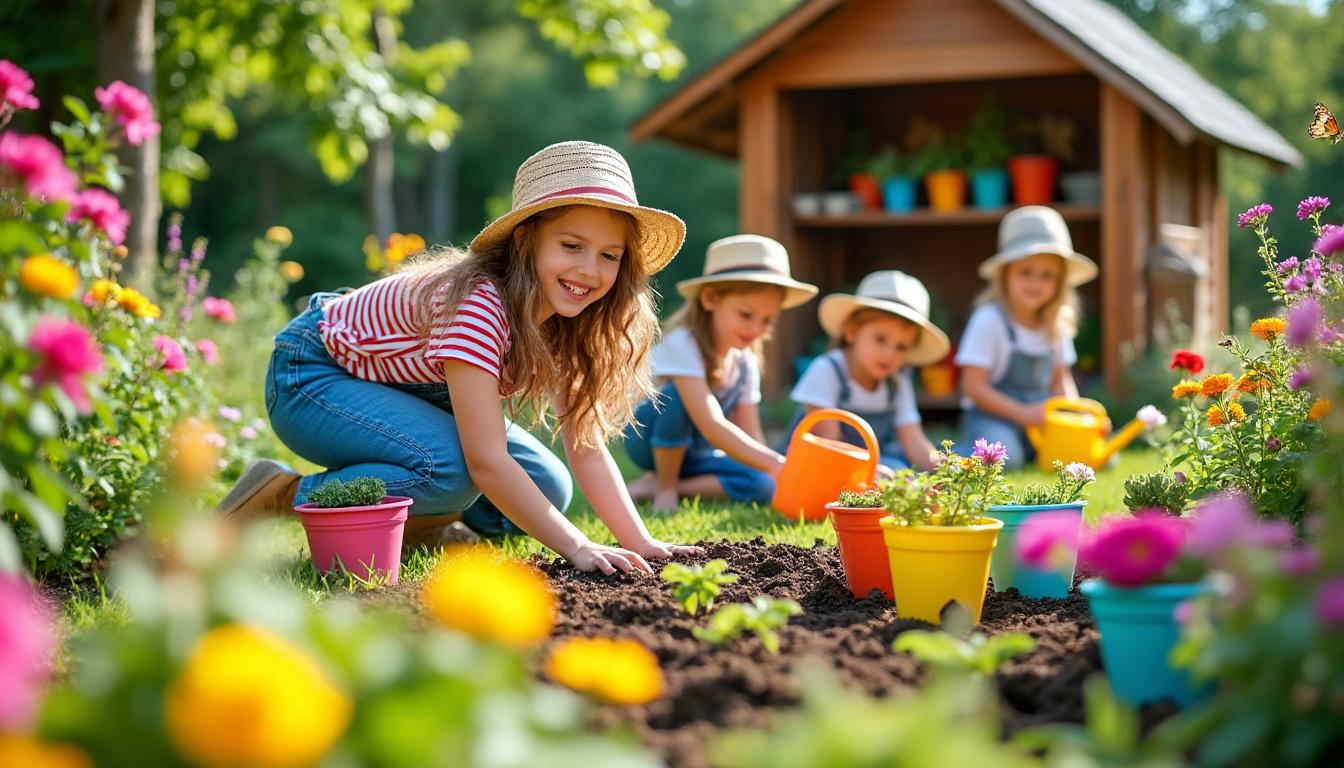Encouraging children to engage with gardening cultivates not only green thumbs but also nurtures essential life skills and a deep appreciation for the natural world. As digital distractions increasingly compete for youngsters’ attention, fostering a passion for plant care becomes an invaluable strategy to reconnect them with the environment. This dialogue highlights pragmatic approaches to inspire young gardeners, leverages tools and programs from leaders such as Kids Gardening and Gardener’s Supply Company, and underscores the role of hands-on experience in developing responsibility and creativity. Exploring these dimensions reveals how to effectively nurture children’s enthusiasm, making gardening both an educational journey and a lasting passion.
Practical Strategies To Engage Children In Gardening Activities And Plant Care
Developing a passion for plant care in children begins with offering meaningful opportunities that harness their innate curiosity. Experts advocate for involving children early, providing them ownership in the process, and tailoring gardening experiences to their preferences and environments.
One effective approach is allowing children to select their own plants. Visiting a nursery together and enabling kids to choose what they want to grow—from vibrant annual flowers to edible vegetables—encourages investment in the project. Firms like The Sprout House and Sproutbrite specialize in child-friendly plant kits that simplify selection and care. Ensuring safety is paramount; plants such as tomato leaves or rhubarb stems are toxic and require supervision, but many non-toxic species abound for young gardeners.
Incorporating child-sized gardening tools from sources like Gardener’s Supply Company or Green Kid Crafts significantly enhances engagement. These tools empower children to actively participate—from digging and sowing to watering—building confidence and fine motor skills. Even simple kitchen spoons can double as garden implements for the youngest enthusiasts.
Designing Personalized Garden Spaces
Creating an individualized plot, whether a small garden bed or container, imbues children with a sense of pride and ownership. They can measure and lay out their territory, aided by yardsticks or garden markers, under adult guidance. Letting them name their garden and individual plants further strengthens this bond, promoting caretaking behaviors and responsibility.
Studies from initiatives like Nature’s Kids and Back to the Roots demonstrate that naming plants encourages children to observe their growth more closely and respond to their needs. This direct interaction homes in on patience and attention to life cycles, vital lessons extending beyond horticulture.
- Allow children to pick plants suitable for their climate and dietary preferences.
- Provide gardening tools scaled to their size and strength.
- Help them establish and personalize their plot or containers with names and decorations.
- Encourage measuring and mapping of garden space to incorporate basic math lessons.
- Supervise but allow experimentation and learning from mistakes.
| Activity | Purpose | Recommended Tools or Resources |
|---|---|---|
| Plant Selection | Building engagement and ownership | The Sprout House kits, Seedlings toolkits |
| Garden Layout and Naming | Fostering responsibility and creativity | Gardener’s Supply Company child rakes and spades, plant markers |
| Tool Use and Maintenance | Developing fine motor skills and confidence | Green Kid Crafts tools, Sproutbrite gloves |
How Gardening Instills Patience, Responsibility, And Healthy Habits In Children
Gardening extends well beyond cultivating plants; it delivers profound life lessons essential for children’s growth and development. Participating in plant care teaches the values of patience, responsibility, and the rewards of nurturing living things over time.
Young gardeners learn that plants need consistent care—watering, feeding, and weeding—that cannot be rushed, helping kids internalize patience. Observing how plants respond to these efforts promotes a sense of cause and effect, encouraging perseverance across challenges. For instance, prematurely picking an unripe tomato offers an immediate, tangible lesson in timing and consequences.
Moreover, regular garden chores enhance responsibility. Children are invited to keep a visible calendar—hung on a bedroom door or refrigerator—to schedule tasks such as watering or fertilizing. This tangible checklist not only sharpens executive functioning skills but also boosts satisfaction as they cross off accomplished responsibilities.
Gardening can also play a critical role in shaping healthy eating habits. Selecting vegetables they enjoy encourages children to try and appreciate homegrown nutrition. Programs by organizations like Kids Gardening and Back to the Roots have shown success in increasing vegetable consumption among children engaged in gardening, impacting long-term dietary preferences.
- Introduce consistent garden chores with visual reminders.
- Integrate lessons on growth cycles to enhance patience.
- Leverage edible plants to promote healthy eating choices.
- Incorporate stories or activities about plant life and care.
- Encourage reflection on successes and learning moments.
| Life Skill | Gardening Activity | Developmental Benefit |
|---|---|---|
| Patience | Waiting for plants to ripen | Enhanced emotional regulation and impulse control |
| Responsibility | Regular watering and weeding | Executive function and time management |
| Healthy Habits | Growing and eating vegetables | Improved nutrition and food literacy |
Building Connection To Nature Through Hands-On Gardening Experiences For Children
Reconnecting children with nature in the digital age is increasingly vital. Gardening offers an immersive, sensory-rich avenue to nurture empathy, environmental awareness, and a lifelong affinity for green spaces.
Hands-on garden activities provide multiple sensory inputs—from the texture of soil to the smell of herbs—that foster curiosity and investigative skills. Children engaged in plant care tend to demonstrate heightened observation abilities and scientific thinking, as they monitor growth stages, weather impacts, and pollinator visits.
Organizations like Nature’s Kids and Little Green Fingers have pioneered outdoor educational programs emphasizing experiential learning that integrates gardening with nature exploration. These efforts help children understand ecological interdependencies, climate impacts, and biodiversity from a young age.
Additionally, gardening can enhance mental and emotional wellbeing. Studies correlate regular time spent in green environments with reduced stress and improved mood in children. The calming rhythm of garden care and the rewarding witnessing of growth nurtures resilience and mindfulness.
- Encourage sensory exploration during gardening activities (touch, smell, sight).
- Integrate nature-focused learning modules led by programs like Little Green Fingers.
- Use the garden to observe wildlife and discuss ecological roles.
- Promote mindfulness through slow, deliberate plant care.
- Facilitate outdoor group gardening to foster social connections.
| Nature Connection Activity | Learning Outcome | Supporting Resource |
|---|---|---|
| Sensory Exploration | Enhanced curiosity and observation | Little Green Fingers curriculum |
| Wildlife Monitoring | Understanding biodiversity | Nature’s Kids workshops |
| Mindfulness Gardening | Emotional resilience and focus | Sproutbrite mindfulness guides |
Leveraging Educational Resources And Community Programs To Sustain Children’s Gardening Interests
Long-term gardening enthusiasm can be reinforced by access to educational materials, structured activities, and community engagement. Leading organizations like Kids Gardening, The Sprout House, and Green Kid Crafts offer curated toolkits, lesson plans, and ongoing support to nurture children’s skills and knowledge.
Community gardens and school gardening programs also play instrumental roles by providing social opportunities and practical experience beyond the home environment. Participating in shared gardens enables children to collaborate on projects, exchange tips, and celebrate collective achievements, reinforcing the social dimension of gardening.
Additionally, digital platforms and newsletters such as Gardener’s Supply Company’s weekly updates and the award-winning Weekly Dirt Newsletter extend ongoing encouragement and tips for gardeners of all ages. Local events and workshops, often found via resources like Kids Garden Passion and Children Gardening Tips, further strengthen community bonds.
- Subscribe to gardening newsletters tailored for children and families.
- Engage children in local community or school garden projects.
- Utilize kits and tools from trusted brands like Back to the Roots.
- Participate in seasonal workshops and fairs.
- Encourage sharing harvests and stories in social or school settings.
| Resource | Type | Benefits for Children |
|---|---|---|
| Kids Gardening | Educational Curriculum | Hands-on learning and environmental stewardship |
| The Sprout House | Plant Kits and Tools | Simplified gardening for children and beginners |
| Green Kid Crafts | Craft and Science Kits | Encourages creativity and scientific exploration |
Creative Ways To Maintain Children’s Gardening Enthusiasm Throughout The Year
Sustaining children’s interest in gardening year-round requires adapting activities to seasonal changes and diversifying the experiences offered. Winter gardening, indoor plant care, and experimenting with fast-growing seedlings can keep young gardeners engaged despite weather limitations.
For example, starting seedlings indoors with kits from My Little Garden or Back to the Roots allows children to witness rapid growth cycles and transplant excitement come spring. Integrating houseplants into daily life supports horticultural curiosity during colder months, supplemented by guidance from specialist resources on Timeless Houseplant Tips.
Seasonal gardening calendars and themed challenges maintain momentum. Resources such as Gardening Tips Late Summer and Winter Gardening Bliss suggest tailored activities that align with seasonal plant cycles, providing a rhythm to gardening care that children anticipate.
- Use indoor seed starting kits during colder seasons.
- Encourage regular houseplant care to build year-round habits.
- Plan seasonal garden projects integrating participant input.
- Create challenges or journals to track progress over time.
- Celebrate milestones with rewards or exhibitions.
| Season | Activity | Outcome |
|---|---|---|
| Winter | Indoor seedlings and houseplant care | Continuous engagement and plant knowledge |
| Spring | Transplanting and planting fast growers | Anticipation and excitement for growth |
| Summer | Outdoor vegetable and flower gardening | Skill development and harvest rewards |
| Fall | Preparing garden for dormancy and composting | Understanding seasonal cycles and sustainability |
Frequently Asked Questions About Encouraging Children’s Gardening Passions
- What are the best plants for children to grow?
Choosing easy-to-grow, non-toxic plants like cherry tomatoes, sunflowers, marigolds, and snap peas helps maintain interest and ensures safety. - How can parents balance supervision with allowing children to experiment?
Set clear safety boundaries but encourage children to make decisions and learn from mistakes, empowering confidence and resilience. - Are there specific tools designed for young gardeners?
Yes, companies like Gardener’s Supply Company and Green Kid Crafts offer scaled-down, child-friendly tools that promote independence. - How does gardening impact children’s mental health?
Gardening reduces stress, boosts mood, and nurtures mindfulness by connecting children with nature and providing a sense of accomplishment. - Where can families find community gardening programs?
Community centers, schools, and resources like Kids Garden Passion provide opportunities for social gardening experiences.

